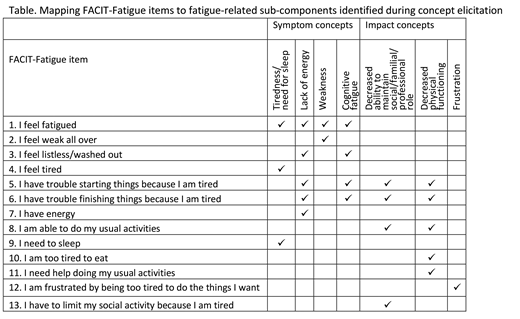Introduction: The FACIT-Fatigue is a 13-item patient-reported outcome instrument (PRO) that was designed to assess fatigue-related symptoms and impacts on daily functioning. This study assessed the content validity of the FACIT-Fatigue in patients with CLL to help determine if it is fit-for-purpose in this population.
Methods: Forty adults with first-line (1L) or relapsed or refractory (R/R) CLL took part in an interview study comprising concept elicitation and cognitive debriefing. All participants had experienced CLL-related symptoms (fatigue, weight loss, fever or night sweats) in the past week. For concept elicitation, interviewers used a standardized semi-structured interview guide with open-ended and prompted questions to explore patients' experiences of the signs, symptoms and impacts of CLL and its treatments. Patients were asked to provide a disturbance rating of these concepts on a 0-10 scale of severity. All interviewed patients completed the FACIT-Fatigue. Item scores can range from 0 ("not at all") to 4 ("very much"), and the total score from 0 to 52; lower scores indicate greater fatigue. The recall period for each item is the past 7 days. The general population mean score is 43 (Cella et al. 2002; Montan et al. 2018). During cognitive debriefing, the clarity of the FACIT-Fatigue items, their relevance to the patients, and the comprehensiveness of the response options were assessed. Interviews were carried out by telephone and lasted about 60-75 minutes. De-identified audio-recorded interviews were transcribed, coded and analyzed using qualitative data analysis software.
Results: Median age of participants was 58 years (range: 28-73 years), and gender distribution was equal. During concept elicitation, fatigue was identified as the most prominent and impactful concept. It was the only concept mentioned by 100% of patients, and almost all (1L: 95%; R/R: 85%) mentioned it spontaneously without prompting. Fatigue had a high mean disturbance rating (1L: 7.1; R/R: 6.9). Seven fatigue-related sub-components were identified from the way that patients described their fatigue, covering symptoms (tiredness/need for sleep, lack of energy, weakness, cognitive fatigue) and impacts (decreased ability to maintain social/familial/professional role, decreased physical functioning, frustration). Mean (standard deviation) FACIT-Fatigue score was 28.9 (13.6) for patients with 1L CLL and 29.3 (11.5) for those with R/R CLL, indicating greater fatigue than the general population and providing further evidence that fatigue is a core component of CLL. The items that scored highest were: "I feel fatigued" (item 1; mean score: 2.4) and "I feel tired" (item 4; mean score: 2.4). The items that scored lowest were: "I am too tired to eat" (item 10; mean score: 0.4) and "I need help doing my usual activities" (item 11; mean score: 1.0). During cognitive debriefing, 100% of patients confirmed that the FACIT-Fatigue was reflective of their experiences with fatigue resulting from CLL. All patients found the response options provided by the FACIT-Fatigue to be sufficient. Patients confirmed that most of the FACIT-Fatigue terminology was clear. An exception was the item "I feel listless/washed out" (item 3), which was not consistently understood: most patients linked it to an absence of both physical and mental energy, but some interpreted it just as a lack of physical energy. Overall, patients considered the FACIT-Fatigue items to be relevant and distinct from each other, and found that the impact items captured both the mental and physical impacts of fatigue. One item, "I am too tired to eat", was not considered to be highly pertinent because, although respondents could imagine that some patients with CLL might be too tired to eat, they themselves could only recall being too tired to prepare a meal, not being too tired to eat. However, respondents felt that the item was still relevant and that it did not detract from the applicability or clarity of the FACIT-Fatigue. Conceptual relevance of the FACIT-Fatigue was supported by mapping of its items to the 7 fatigue-related sub-components identified during concept elicitation (Table).
Conclusions: Results from concept elicitation and cognitive debriefing interviews demonstrated content validity of the FACIT-Fatigue in patients with CLL with 1L or R/R disease, thus providing evidence that it is fit-for-purpose in this population.
Chung:AstraZeneca: Employment, Equity Ownership. Eek:AstraZeneca: Employment, Equity Ownership. Eyre:Janssen: Honoraria; Gilead: Consultancy, Honoraria, Other: commercial research support; Abbvie: Honoraria; Roche: Honoraria.
Author notes
Asterisk with author names denotes non-ASH members.


